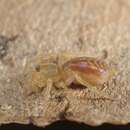en
names in breadcrumbs


The spider family Clubionidae (sac spiders) includes around 581 described species (Platnick 2013). Around 58 of these occur in North America north of Mexico (Bradley 2013). Clubionids are wandering hunters and do not build webs to capture prey, although they do make sac-like silken retreats, often in rolled leaves, for molting and for depositing egg sacs. Clubionids are mostly medium-sized, light-colored spiders that are active at night. They occur on foliage, beneath loose bark, in leaf litter, and under rocks (Edwards 1958). The common name "sac spider" is derived from the fact that they build a compact silk retreat each morning before becoming inactive until the evening (Bradley 2013). Like most spiders, clubionids have eight eyes.
Historically, a broad range of spiders with two tarsal claws have been included in the Clubionidae. A number of families formerly treated as subfamilies within Clubionidae are now treated as distinct families and several genera formerly included in the Clubionidae are now placed in families that were always considered distinct from the Clubionidae. Some issues related to the delineation of this family remain, however, such as whether Cheiracanthium is a clubionid or, instead, belongs in the family Miturgidae (Richman and Ubick 2005 and references therein). The Nearctic clubionids were revised by Edwards (1958) although there have been a number of additions since then (see Richman and Ubick 2005 and references therein). Clubionids can be distinguished from similar-looking spiders in the family Gnaphosidae by their conical spinnerets. In clubionids, these are arranged in a compact cluster that rarely extends beyond the end of the abdomen. In contrast, gnaphosids have conspicuous cylindrical spinnerets, which are often visible from above. (Bradley 2013)
The sac spiders of the family Clubionidae[1] have a very confusing taxonomic history. Once, this family was a large catch-all taxon for a disparate collection of spiders, similar only in that they had eight eyes arranged in two rows[2] and conical anterior spinnerets that touched, and were wandering predators that built silken retreats, or sacs, usually on plant terminals, between leaves, under bark, or under rocks. These are now recognized to include several families, some of which are more closely related to the three-clawed spiders, like lynx and wolf spiders, than to Clubionidae and related families.[3]
The remnant Clubionidae now consist of a few over 500 species in 18 genera worldwide. However, "sac spider" used on its own should imply a member of the family Clubionidae, but other common names may use the phrase "sac spider" including:
As of January 2023, the World Spider Catalog accepts the following genera:[4]
Additionally, the World Spider Catalog considers Carteroniella Strand, 1907 to be a nomen dubium.
In North America, the family as it is now recognised consists of only two genera, Clubiona and Elaver (formerly Clubionoides). Clubiona is nearly worldwide in distribution.
The sac spiders of the family Clubionidae have a very confusing taxonomic history. Once, this family was a large catch-all taxon for a disparate collection of spiders, similar only in that they had eight eyes arranged in two rows and conical anterior spinnerets that touched, and were wandering predators that built silken retreats, or sacs, usually on plant terminals, between leaves, under bark, or under rocks. These are now recognized to include several families, some of which are more closely related to the three-clawed spiders, like lynx and wolf spiders, than to Clubionidae and related families.